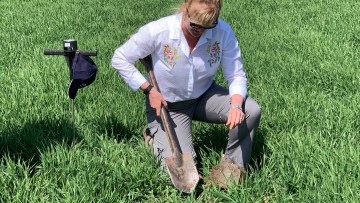Real Results Roadshow - Jenni Dungait Soil Paper
01.05.2020

Professor Jenni Dungait, Soil Health Expert.
Climate change is here, and this, coupled with a shift towards new Environmental Land Management schemes by the UK Government, where some farm payments are likely to be determined by soil health, will affect the way growers manage their soils.
Professor Jenni Dungait who runs an independent soil science consultancy, Soil Health Expert, said, “Climate change is affecting us all. With UK rainfall in February 237% more than the average, we really have to think about using soils to help us solve flooding problems. Going forwards we are going to have to farm in a different way to manage these extreme conditions. As farmers, if you are looking after the land and you can get paid to moderate and manage this then it is a positive. Water is a resource that we are lucky to have, we have to learn to manage it better.”
Soil consists of minerals, organic matter, water and air. The ideal soil has the same amount of air as water in it, approximately 20-30%. If soils are managed to maintain these air and water contents then they will function better, providing an environment that roots grow in and other biological agents thrive in, including those important in nutrient cycling. Jenni said, “If there is more air in the soil, waterlogging and flooding can be prevented, just 20% airspace in 30 cm depth of soil can absorb 60 mm of rain before reaching saturation.”
There are three major pathways for water to take when it falls on soil. The first, surface flow is the most rapid. Jenni said, “We want to manage things so the water is not moving rapidly across the soil. If you are managing your soils poorly you are giving water every opportunity to flow quickly over the soil surface and into outflow.”
Subsurface flow, however, is desirable. “Here, it is supplying water and nutrients to your plant roots and it is moving much more slowly.”
The third, groundwater flow, is needed as an aquifer for drinking water and also as the source of water during drought.
So, what can growers do to affect these pathways and make the soil absorb as much water as possible?
Jenni said, “When it comes to increasing soil porosity, biology is your friend. Almost all water that moves through soil moves through macropores, many made by biological organisms. All these organisms want is some organic matter as a food source and minimum mechanical soil disturbance. These are the kind of fundamentals that underpin the idea that you can regenerate soils and your farm by using zero and min till.”
Soil organic matter also creates and stabilises soil aggregates. Jenni said, “Even a small increase in the amount of carbon in the soil can make a big difference as it feeds the soil biology, which produce the gums and exudates to hold the soil structure together. In times of flooding, the soils with lots of carbon will stay intact and will regenerate and recover more quickly once the water drains through.”
In comparison, a soil that has been poorly managed, losing soil organic matter through tillage and compacted and compressed from repeated use of heavy machinery, will have water move across the top, rather than down through the profile. Jenni added, “Drainage is also really important, so mechanical drainage is entirely necessary in most soils in this country. Check your drains and outflows to make sure they are functioning as well as possible. If your soil gets flooded it is not good for anything on or in the soil.”
Cover crops, green manures and mulches protect the soil, providing an armour as well as encouraging earthworm activity. If the soil is bare and an intense rainstorm occurs, as is happening more often, bare soil on the surface will be smashed by the intensity of the raindrops, even if there is good aggregate structure. “This gets eroded by the water and those soil particles have nutrients bound to them so those move too. It’s your capital just moving off your land.”
After only 2-3 days of flooding plant roots become damaged because of a lack of oxygen with 100% losses of winter crop and grass starting to die after 15 days.
Jenni said, “It is important that growers understand their soil; if it has good structure, whether it could cope with flooding and how quickly it would drain, and this understanding allows them to establish a baseline from where their soils can be seen to be improved. There are tools available to do this. By using the mySoil app growers are able to access a soil properties map which will give details on the texture of their soil.
Soil texture affects water flow through the soil. Soils made up of clay particles, which are very fine, don’t have very big holes between them and become blocked easily, whereas sand does not, as the holes between the particles are larger.
The Visual Examination of Soil Structure (VESS), developed by SRUC, is widely used to assess topsoil. This involves three easy steps, and then a score is given indicating if the soil needs to be improved to maintain soil health.”
An infiltration test can be carried out to find out how much water the soil can absorb. Jenni said, “A piece of drainage pipe, a stopwatch and a bottle of water is all you need. Penetrometers can also be used; they can give an indication of how compacted soils are and provide a quick way to assess the field without digging.”
Resources recommended by Prof. Jenni Dungait:
